- Wondering how to get Monopoly GO! free rolls? Well, you’ve come to the right place. In this guide, we provide you with a bunch of tips and tricks to get some free rolls for the hit new mobile game. We’ll …
Best Roblox Horror Games to Play Right Now – Updated Weekly
By Adele Wilson
Our Best Roblox Horror Games guide features the scariest and most creative experiences to play right now on the platform!The BEST Roblox Games of The Week – Games You Need To Play!
By Sho Roberts
Our feature shares our pick for the Best Roblox Games of the week! With our feature, we guarantee you'll find something new to play!All Grades in Type Soul – Each Race Explained
By Adele Wilson
Our All Grades in Type Soul guide lists every grade in the game for all races, including how to increase your grade quickly!
Crash Club Review: Fender Bender
Crash Club is the third release from Australian indie development studio Prettygreat, who brought us the instantly addictive soda jerk simulator Slide the Shakes last year and the phenomenal endless swag-grabber Land Sliders in 2015. Like its predecessors, Crash Club …
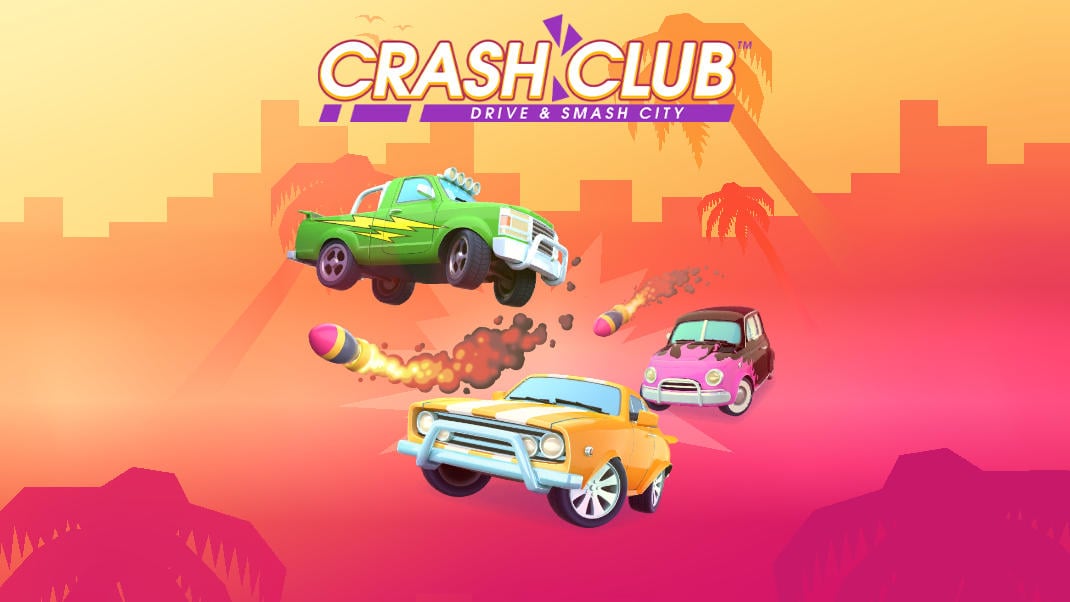
Crash Club is the third release from Australian indie development studio Prettygreat, who brought us the instantly addictive soda jerk simulator Slide the Shakes last year and the phenomenal endless swag-grabber Land Sliders in 2015. Like its predecessors, Crash Club is a vibrant labor of love with smooth controls, a clever arcade concept, and tons of unlockables for players to collect. Its core gameplay—haphazardly driving around a destructible city while dodging and attacking other crash-happy motorists—is extremely enticing and should initially appeal to fans of high score chasers, multiplayer arena battles, and Not Doppler’s recent release, Crash of Cars. However, a number of Crash Club’s design decisions negatively impact the in-game experience, resulting in matches that are often a repetitive slog with less player agency than we’d like in a multiplayer smash ‘em up.
Crash Club is a strictly online experience, vaguely comparable to the recent wave of .io games in its execution. You have a home hub from which you can view your stats and current cars or purchase new items, but the minute you push “Play!” you’ll be dropped into an already-active game. Matches go on indefinitely, with new players entering as other players are killed and knocked out. This means you can—and often will—leave a match after being wrecked and end up back in the same group, ready to take revenge upon whomever last thwarted you.
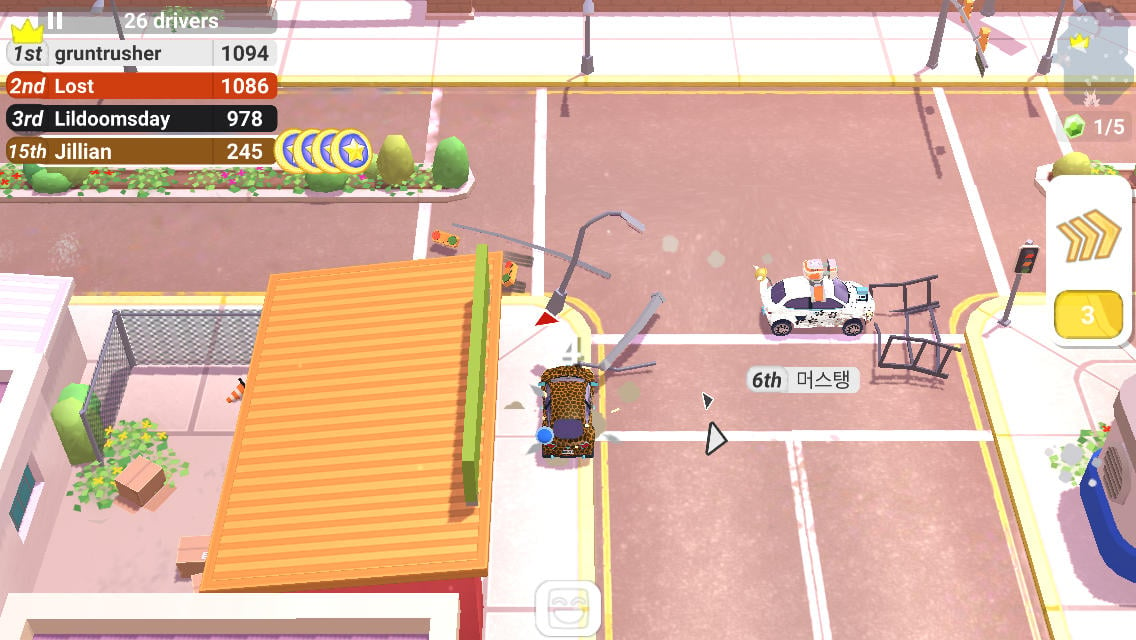
The goal in Crash Club is simply to get the highest score and climb the in-game leaderboards. You earn points two ways: smashing and crashing. Most of the environment you come across, except for buildings, is smashable. Trees, fences, dumpsters, traffic lights, statues, and more: if your car can run it down, it can be smashed for points. The point values of objects vary—typically by size—so knocking over a water tower will earn you a bigger bonus than clipping a few traffic cones, but the cones will be a much more frequent source of score-padding.
The other way you can boost yourself up the leaderboard is by crashing other cars. While you’re driving around the breakables-cluttered city, other players will be doing the same. Matches generally consist of 20-30 cars total, so even on the surprisingly large beachside map, you’re going to run into opponents quite often. Unlike Crash of Cars, which lets players use a combination of weapons and their own vehicles as deadly battering rams, cars in Crash Club can only be taken out with projectiles. This adds a bit of an interesting twist to the online experience, since cars without any weapon attached to their hood are obviously not a current threat—but they could be easy targets for a player just looking for quick kills. There’s a definite “Should I or shouldn’t I?” and “Will he or won’t he?” for armed and unarmed players, respectively, since wasting ammo on an unarmed player can always put you in a compromised position if another opponent suddenly appears.
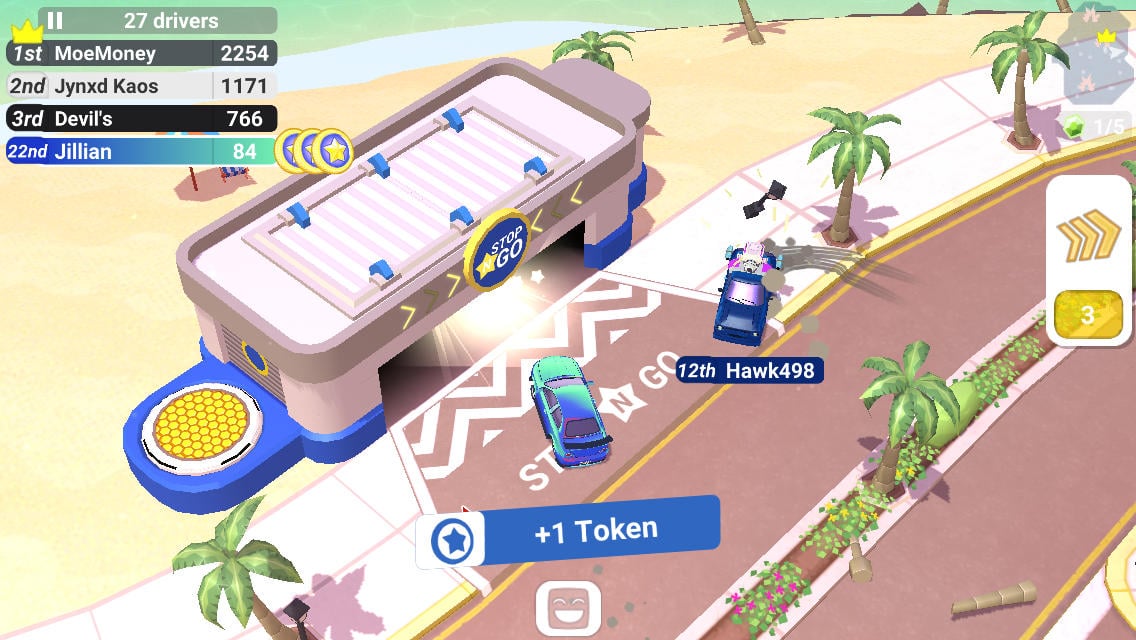
The weapons and method of attack are our first major complaint about Crash Club, however. There are four weapons available in the game—the Peashooter, Blaster, Zap Cannon, and Rockets—and each has a different ammo count and does a unique amount of damage. For instance, the Peashooter has the largest clip at 20 shots available, but only does a maximum of four damage per shot. The Zap Cannon always does nine damage, but you have a measly five shots available at maximum capacity. The problem is that all of the weapons, to slightly varying degrees, are able to attack through walls and auto-lock on to players. Instead of having to position yourself just right to successfully hit an opponent, you need only be in their general vicinity and tap on their vehicle. While we can see the logic in this—it allows fast-paced vehicular battles to play out without anyone slowing down or fumbling with controls—it also hugely detracts from any sense of satisfaction you might get from taking down an opponent. It’s frustrating to die to a distant laser beam from across a building, and it’s not especially entertaining to kill someone that way, either. This rule of “on screen, can shoot” also takes away from the fun of skillfully dodging down back alleys or quickly turning corners to lose someone because, essentially, you can’t. Your pursuer can still just hit you from outside the alley, so the only real way to escape is using your turbo booster and hoping they don’t do the same.
There is one other option for players seeking to escape a jam: scattered about the map are Stop-N-Go body shops that can be entered as long as you have a Token available. Tokens are dropped randomly from smashed terrain, so as long as you’ve been running over stuff you’ll probably have at least one on hand. While inside the Stop-N-Go (after the initial entrance animation) you cannot be targeted by opponents. These shops sell the weapons players equip, as well as repairs for damaged vehicles, turbo refills, and a few other enhancements, like increased armor or map visibility. These shops are often the go-to respite for players on the losing end of a battle, as well as anyone with Tokens to spare looking to beef up their ride.
https://www.youtube.com/watch?v=A_xHAL-c3HU
These Stop-N-Go shops are a major contributor to another issue with Crash Club: matches go on for a long time. For a mobile, drop-in multiplayer game, we’re surprised by how long the average game takes. While there will inevitably be matches where you’re wrecked and booted almost immediately, more often than not you’ll be in a game for 20 minutes or longer. This is partly due to the fact that Stop-N-Go shops are prevalent on the map, and it’s usually possible to reach one before dying. On top of this, there’s no limit to the number of players that can enter a single Stop-N-Go: so, a large battle with multiple cars could easily result in all of the opponents rushing into the nearest Stop-N-Go for a repair and refresh. The result is a slow grind of alternating between smashing and repairing, losing kills to garage escapes and eking out similar breakaways yourself.
When a match does finally end, you’ll earn EXP and coins based on your final score and the number of cars you wrecked. The EXP is used to unlock early-level options, like the ability to paint or tune up your car, and ongoing coin and gem rewards. Coins are used to buy decorations or special abilities for your vehicles, while gems are the only way to earn new cars. Everything, from antennae toppers to vehicle powers, are unlocked in a randomized gacha without any way to buy specifically what you want. It’s a bit reminiscent of Splatoon’s method of power-imbibing, since you can turn Common cars with no abilities into Legendary ones with three powers—if you have enough coins—but you don’t get to pick your powers directly.
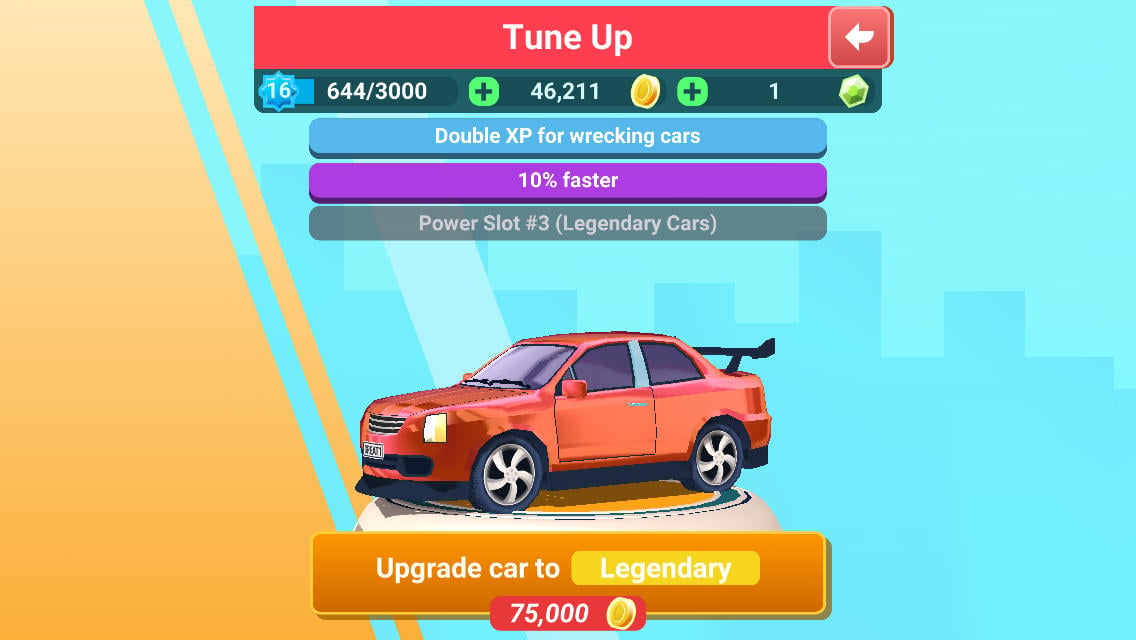
Besides trying to unlock cars with better powers—we personally feel abilities that reduce the damage you take from weapons are greatly superior to those that give you bonus points or highlight Stop-N-Go locations on the map—there’s not much reason to waste premium gems on new vehicles. All of the cars feel roughly the same while playing, without a noticeable difference in speed or handling. Our compact car feels like our sedan which also feels like our utility SUV. It doesn’t help that there’s a distinct lack of information about not only your vehicles—no stats besides any special abilities you’ve unlocked—but also within matches themselves. Cars don’t have visible health bars of any kind, but instead smoke slightly after taking some damage and catch on fire when very near-death. You can see the damage you are doing to opponents via numerical pop-ups on their car when your projectiles hit, but you don’t see any sort of similar damage recognition on your own car. This means you really only have the faint smoking and flaming to go by to decide when you need to repair, besides paying extremely close attention to what weapons you think have hit you and about how much damage you’ve probably taken. We assume this was an intentional design choice by Prettygreat, but it makes your Stop-N-Go purchases feel like a guessing game rather than a tactical decision, and it turns battles into frustrating randomized dice rolls since you can’t tell if your opponent has a damage boost or how many of their shots actually landed.
While these are significant issues that detract from the game in its current form, there are still plenty of things to love here. The controls are, as expected from Prettygreat, extremely smooth and tactile. There’s a wide variety of control schemes and combinations available, and the default of sliding your fingers to swerve your car left or right is the perfect level of responsive. You can assign all of your activities to swipe controls, creating a sort of conductor’s baton of a car-smashing symphony, or use the on-screen buttons instead. Driving around simply feels good.
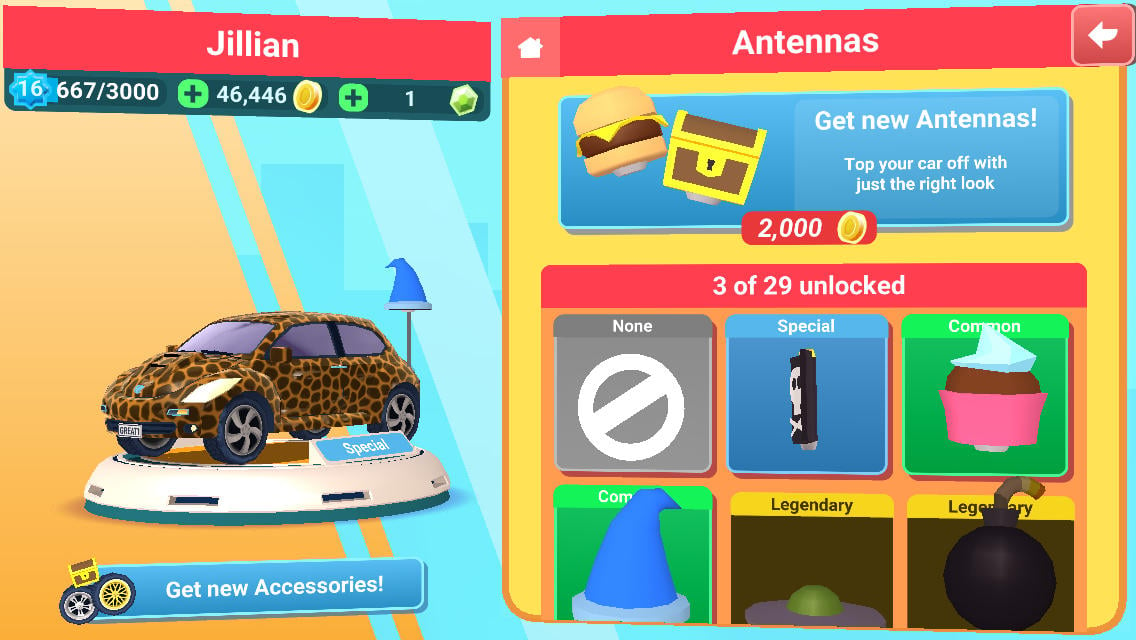
We love that there’s a definitive reward for reaching first place in a match: the current leader earns double points for everything they do, so those five-point trees are now worth ten points with every knock-down. It makes reaching first place and enduring the risks that come along with it—players hunting you down with ease as they teleport to your location directly—worth the effort. Your car is also transformed into a glowing, crowned monster truck while you’re in the lead, adding a fun visual flair to the rewards package.
Speaking of visuals, Crash Club is packed to the brim with different paint colors, antennae toppers, decals, and vehicle variations. You’ll essentially never see the exact same car twice thanks to all the slight differences—from wheels to spoilers to window tint—and there will always be something new to unlock. Collectibles fans will have a field day filling out their garage with every customization option, although you can only store five different vehicles at a time before needing to sell one off.
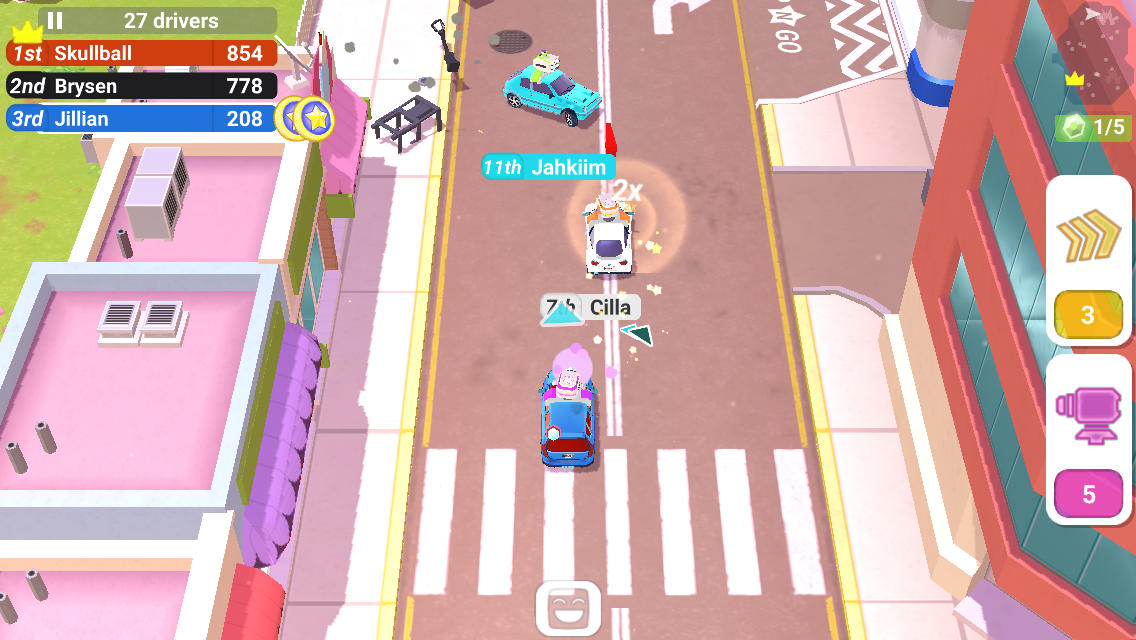
Finally, we really enjoy the aspect of growing within the match itself and becoming more powerful the longer you survive. Purchasing health regeneration, armor, and visibility upgrades from the Stop-N-Go makes your car that much stronger for the duration of the current match and provides another reward for simply staying alive. This feature likely contributes to the extended duration of matches—all of the progressive items are designed to help you survive longer—but we could see future updates balancing this with purchasable offensive upgrades (besides the double attack power boost that only lasts 20 seconds).
All considered, Crash Club is a mixed bag. Its base gameplay of smashing through the sprawling city and pummeling other vehicles is fun, but not fun enough to sustain its 20-plus-minute matches. Its weapons and upgrades provide a unique sense of in-game progress, but its auto-lock projectiles that fire through walls detract from the sense of carefully maneuvered kills or skillful driving. Its vehicles come in a wide variety of shapes, sizes, and decorations, but they all drive essentially the same. Matches are easy to find and play mostly lag-free despite containing up to 30 players at one time, but there is no offline or single-player mode for practice or data-less games. The map is a beautiful San Francisco-esque cityscape with a variety of locations and playful Land Sliders Easter eggs scattered about, but it’s the only map in the game and it never changes. All of these features, good and bad, are built on the just-plain-fun idea of multiplayer car-smashing mayhem that Crash Club sometimes gets right—and other times drives right by.

The good
- Smooth and simple controls that make it easy to master the art of city- and car-smashing.
- Tons of car customization options ranging from cupcake antennae to emoji horns.
- Reaching first and barreling around in a monster truck earning double points is always fun.

The bad
- Battles feel based more on luck than skill due to projectiles being auto-lock-on and unavoidable.
- A lack of information in-game and out, like health bars or car statuses, makes it hard to know your current standing.
- Matches stretch on extremely long for a mobile multiplayer game.
- Between all of the cars feeling roughly the same, the single map, and weapons all being slight variations on projectiles, there's a lot of repetition.
More articles...
Monopoly GO! Free Rolls – Links For Free Dice
By Glen Fox
Wondering how to get Monopoly GO! free rolls? Well, you’ve come to the right place. In this guide, we provide you with a bunch of tips and tricks to get some free rolls for the hit new mobile game. We’ll …Best Roblox Horror Games to Play Right Now – Updated Weekly
By Adele Wilson
Our Best Roblox Horror Games guide features the scariest and most creative experiences to play right now on the platform!The BEST Roblox Games of The Week – Games You Need To Play!
By Sho Roberts
Our feature shares our pick for the Best Roblox Games of the week! With our feature, we guarantee you'll find something new to play!All Grades in Type Soul – Each Race Explained
By Adele Wilson
Our All Grades in Type Soul guide lists every grade in the game for all races, including how to increase your grade quickly!







